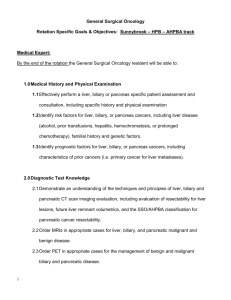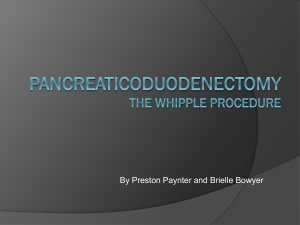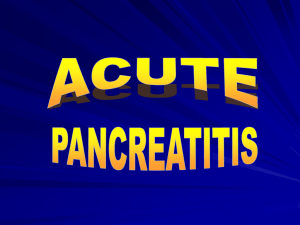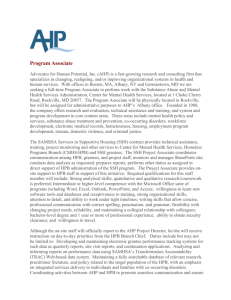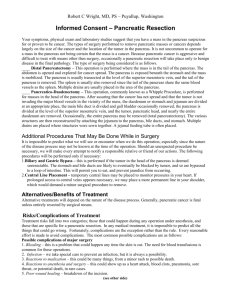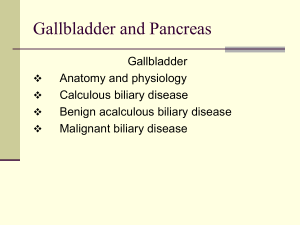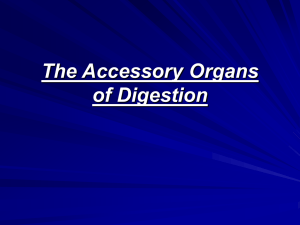Care of the Hepato-Pancreato-Biliary (HPB) Patient
advertisement
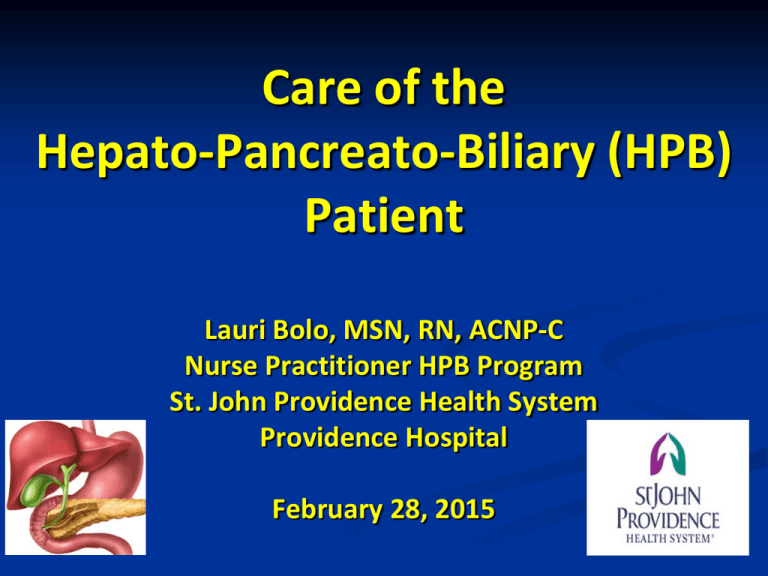
Care of the Hepato-Pancreato-Biliary (HPB) Patient Lauri Bolo, MSN, RN, ACNP-C Nurse Practitioner HPB Program St. John Providence Health System Providence Hospital February 28, 2015 Disclosures None Objectives The role of the NP in the HPB program Provide an overview of Pancreas and Liver Cancer Discuss the perioperative care of the HPB patients Discuss the common postoperative complications of the HPB patient HPB Nurse Practitioner (NP) Since 2007 HPB Clinic & Inpatient Navigate patients & families Act as a resource or point of contact Manage patient/family telephone calls re; symptom management & concerns; Goal: Avoid ER HPB NP Initial Visit PreOp Educate and counsel patient and family regarding surgical treatment and recovery Act as a resource or point of contact, available for questions or concerns HPB NP Initial Visit PreOp Surgery Daily inpatient rounds and assessment Evaluate labs, diagnostics tests, vitals, fluid status Monitor and adjust medications as necessary Manage post operative pain, nausea, wound care, & nutrition Ensure patient progression along care pathway Facilitate discharge from hospital • Collaborate with SW, PT/OT, case management • Assess patient readiness • Prepare prescriptions • Educate • Dictate d/c summary HPB NP Initial Visit PreOp Surgery Post Op & Continued Care Drive appropriate follow up care and consults Post operative follow up care Pain control Provide education on lifestyle changes Provide emotional support and resources to newly diagnosed cancer patients Ensure continued surveillance of cancer patients The Pancreas Pancreatic Cancer 46,420 estimated new cases in 2014 39,590 estimated deaths in 2014 3% of all cancers in the U.S. 4th leading cause of cancer death in the United are Pancreas Cancer States Cure is rare and only in resected patients American Cancer Society. Cancer Facts and Figures 2014. Atlanta: American Cancer Society; 2014. Pancreas Cancer: Background Cure is rare and only in resected patients In 100 patients with adenocarcinoma of the pancreas Only 15-20 will have resectable disease Most patients present with locally advanced (50%) or metastatic (35-40%) disease Of these, 3-4 patients will have long term survival Outcomes: Optimist view: 20% surgical cure rate Pessimist view: 3-4% overall cure rate Types of Pancreas Neoplasms Cystic Serous Cystadenoma Mucinous Cystic Neoplasm IPMN Solid Adenocarcinoma PNET Metastatic Solid pseudopapillary tumor Symptoms on Presentation Body and Tail Head Weight loss Jaundice Pain Anorexia Dark urine Light stools Nausea Vomiting Weakness Pruritus Diarrhea Melena Constipation Fever Hematemesis 92 82 72 64 63 62 45 37 35 24 18 12 11 11 8 Weight loss Pain Weakness Nausea Vomiting Anorexia Constipation Hematemesis Melena Jaundice Fever Diarrhea 100 87 43 43 37 33 27 17 17 7 7 3 Treatment Surgery is the only chance of cure Treatment Surgical resection Tumors in the head/uncinate process Tumors in the body & tail Whipple Distal pancreatectomy ±splenectomy Preoperative Workup Labs Nutrition Imaging- U/S, CT Pancreas Protocol, MRI/MRCP LFTs, CA19-9, CEA, CMP, CBC, Prealbumin, Coags Staging EUS/Biopsy Preoperative Workup Selective patients with severe jaundice require preoperative biliary drainage/decompression ERCP (GI) Percutaneous biliary drainage (IR) Whipple Procedure Pancreaticoduodenectomy Whipple Procedure Pancreaticoduodenectomy Removal of the pancreatic head, entire duodenum, gallbladder, and common bile duct Indications for the Whipple Pancreatic head mass Cholangiocarcinoma of the distal bile duct Ampullary tumor Duodenal tumor Chronic pancreatitis Most common Least common Distal Pancreatectomy Distal Pancreatectomy Tumors in the body & tail of the pancreas Splenectomy vs spleen preserving Vaccines LOS Total Pancreatectomy Total Pancreatectomy Rare Benign & malignant disease Diffuse IPMN Chronic Pancreatitis Margin + panc cancer Unresectable Pancreatic Cancer PALLIATIVE Relief of obstructive jaundice Prevention of duodenal obstruction Pain control Palliation of Unresectable Pancreas Cancer Non Surgical Interventions Surgical Endoscopic biliary stent Choledochojejunostomy Percutaneous Transhepatic Cholangiogram drainage & stent Gastrojejunostomy Post-Op Care Pancreas Post-Op Care Ambulation Medications Diet NGT removal Urine output Labs CBC for bleeding risk Electrolytes BUN/Crt for fluid management LFTs Antibiotics- perioperative DVT prophylaxis Pain management IV PCA Epidural PCA IV narcotics Toradol PO narcotics Pancreas Post-Op Care Drains Anterior & Posterior to anastomoses Volume Character of fluid Drain Amylase Removal Splenectomy Vaccines Vaccine pneumococcal vaccine (pneumovax 23) haemophilus influenzae type B (hib TITER) meningococcal vaccine Route Revaccination SQ 5-6 years SQ IM 5 years none * Annual influenza vaccines are recommended. Complications Early Complications Wound infection Anastomotic leak Gastrojejunostomy (2-3%) Hepaticojejunostomy (5%) Pancreatic (10-25%) Delayed gastric emptying (DGE) (~20%) Hemorrhage Pancreatic Fistula/Leak Amylase rich fluid – 3x serum, POD #3 Grade ABC Clinical signs Abdominal pain +/- distention Ileus DGE Fever Tenderness Leukocytosis Pancreatic Fistula (PF) Management Most pancreatic fistulae are of grade A and can be managed non operatively with continued peripancreatic drains placed intraoperatively Few patients might require an CT guided drain placement by Interventional Radiology to control the PF (Grade B) Rarely patients require a surgical intervention (Grade C) Delayed Gastric Emptying Postoperative inability to tolerate diet Management Treatment NG for decompression Prokinetic agents Patience Nutrition Enteral feeds via post pyloric NJ tube or surgical J tube TPN Discharge Medications Lovenox Metoclopropamide Proton pump inhibitor (PPI) Oral analgesics Laxatives Creon Drain teaching Home care Activity & restrictions Diet Insulin Late Complications Pancreatic insufficiency Diabetes Marginal Ulcers Dumping Strictures Iron deficiency anemia Cancer recurrence Short Term & Long Term Follow Up Surgery Oncology Endocrine Surveillance Office visits Imaging Tumor markers Liver function testing CMP The Liver Functions Synthetic- albumin, transferrin, clotting factors Synthesizes bile for fat absorption Detoxifies drugs and toxins Hepatic Tumors Benign Malignant Hemangioma Focal nodular hyperplasia (FNH) Hepatocellular carcinoma (HCC) Colorectal cancer metastases (CRC) Cholangiocarcinoma Adenoma Liver cysts Hepatocellular Carcinoma (HCC) Most common primary malignant tumor of the liver 35,660 estimated new cases in 2015 24,550 estimated deaths in 2015 Risk Factors: hepatitis B, hepatitis C, cirrhosis, alcohol, biliary cirrhosis, hemochromatosis HCC Symptoms Nonspecific Abdominal pain Early satiety Weight loss jaundice Physical findings Abdominal mass Splenomegaly Ascites Colorectal Cancer Metastases 2nd most common cause of cancer related deaths in the US ~ 136,830 will be diagnosed CRC this year ~50% of all patients with colorectal cancer develop metastases Surgical resection offers best outcome American Cancer Society. Cancer Facts and Figures 2014. Atlanta: American Cancer Society; 2014. Cholangiocarcinoma Malignancy of the extrahepatic or intrahepatic ducts Sx of biliary obstruction Jaundice, pruritus, dark urine, clay colored stools Preop Workup Labs LFTs, AFP, CMP, CBC, Prealbumin, Coags Imaging – U/S,CT, MRI Staging If resectable no bx Degree of Cirrhosis Childs Pugh Portal vein embolization (PVE) Biliary drainage Child Pugh Classification Parameter Points assigned 1 2 3 Absent Slight Moderate None Grade 1-2 Grade 3-4 Bilirubin <2 mg/dL 2-3 mg/dL > 3mg/dL Albumin > 3.5 g/dL 2.8-3.5 g/dL <2.8 g/dL <4 4-6 >6 < 1.7 1.7-2.3 >2.3 Ascites Hepatic encephalopathy Prothrombin time Seconds over control INR Grade A = 5-6 points Grade B = 7-9 points well compensated disease *good operative risk significant compromise Grade C = 10-15 points decompensated Portal Vein Embolization (PVE) Selectively embolize the portal vein of the pathologic lobe to allow hypertrophy of remnant liver to prevent post op liver failure Surgical Resection of Hepatic Tumors Right hepatectomy Left Hepatectomy Trisectionectomy Biliary reconstruction Lap Vs Open Post-Op Liver Ambulation Diet Drains UOP Medications Vitamin K No toradol Labs CBC LFTs Coags BUN/Crt Electrolytes – phos & mag Ammonia Post-Op Complications Liver failure Bile leak Infection Bleeding Pleural effusion Ascites PV Thrombosis Liver failure Deterioration in the ability of the liver to maintain its synthetic, excretory, and detoxifying functions increased INR hyperbilirubinemia Early recognition and initiation of supportive care is important Bile leak Rare (5%) Management Most are managed non operatively by following drain output Few might require biliary drainage procedures PTC ERCP Rarely patients require surgical intervention Short Term & Long Term Follow Up Surgeon Oncologist Hepatologist Thank you! Questions?????
